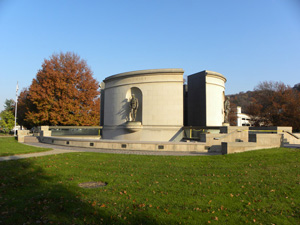

Remember...
James Samuel Findley
1915-1944
"This is undoubtedly the greatest American battle of the war, and will, I believe, be regarded as an ever famous American victory"
Winston Churchill
 |
Remember...James Samuel Findley
|
James Samuel Findley was born on December 9, 1915, to Benjamin Franklin (known as Frank) and Nellie Skinner Findley in Harrison County, West Virginia. His brother and sisters were Avis, John, and Frances.
Throughout the 1920s and 1930s, Frank Findley was a conductor in the railroad industry. Mrs. Findley was a teacher in the public school system in the 1920s and was not working outside of the home by 1930. In 1940, Mr. Findley was a yard foreman for a steam railway. By that time, James S. Findley was no longer living at home. He had married Evelyn Garrett, who was a schoolteacher. He worked as a clerk for Hazel Atlas Glass Company. According to city directories for Clarksburg found on Ancestry.com, the families lived in Clarksburg.
James Findley registered for military service on October 16, 1940. At the time he enlisted, on April 29, 1944, he had attended college for a year and had become a warehouse foreman at the Westinghouse plant, near Fairmont. He enlisted at Fort Thomas, Newport, Kentucky and was placed with a tank battalion (61st Infantry Battalion). ("Local Soldier Is Killed, Sailor Is Missing in Action," Fairmont West Virginian, 8 January 1945.)
The 10th Armored Division arrived in Europe at Cherbourg, a French port, in September 1944. From there, it advanced east into Lorraine. (U.S. Holocaust Memorial Museum, "The 10th Armored Division during World War II," Holocaust Encyclopedia, accessed 30 October 2021, https://encyclopedia.ushmm.org/content/en/article/the-10th-armored-division.)
In December 1944, Adolph Hitler attempted to split the Allied force with a surprise attack into the Ardennes Forest region of the Western Front. German armies suddenly thrust through the Allied lines and pushed through the Ardennes. This excursion drawn on a map, the front line began to appear bulged around advancing German troops. According to one source,
On December 16, three German armies (more than a quarter-million troops) launched the deadliest and most desperate battle of the war in the west in the poorly roaded, rugged, heavily forested Ardennes. The once-quiet region became bedlam as American units were caught flat-footed and fought desperate battles to stem the German advance at St.-Vith, Elsenborn Ridge, Houffalize and, later, Bastogne, which was defended by the 101st Airborne Division. The inexperienced U.S. 106th Division was nearly annihilated, but even in defeat helped buy time for Brigadier General Bruce C. Clarke's brilliant defense of St.-Vith. As the German armies drove deeper into the Ardennes in an attempt to secure vital bridgeheads west of the River Meuse quickly, the line defining the Allied front took on the appearance of a large protrusion or bulge, the name by which the battle would forever be known. ("The Battle of the Bulge," Documentary Heaven, accessed 2 November 2021, https://documentaryheaven.com/the-battle-of-the-bulge/.)
This was the Ardennes Alsace Campaign, also known as the Battle of the Bulge. ("Battle of the Bulge," History.com, 14 October 2009, last updated 22 July 2020, accessed 31 October 2021, https://www.history.com/topics/world-war-ii/battle-of-the-bulge.) The 10th was located south of the region where the Battle of the Bulge began, with the 3rd Army. They were moved north to fight for the towns most threatened by the German incursion.
The Battle of the Bulge was the costliest action ever fought by the U.S. Army, which suffered over 100,000 casualties. ("The Battle of the Bulge," History.com.) Another hallmark of this campaign was the terrible weather. Snow and ice reigned, and temperatures often fell below zero degrees Fahrenheit. The battle would not definitively belong to the Allies until the weather cleared, and air support was able to intercede with strafing rounds, bombs, supplies and paratroopers. ("WWII - European Theater of Operations/Ardennes Alsace Campaign [1944-45]," TogetherWeServed, accessed 31 October 2021, https://army.togetherweserved.com/army/servlet/tws.webapp.WebApp?cmd=SBVTimeLine&type=Person&ID=336743.)
The campaign period was December 16, 1944, through January 1945. The 10th Armored Division entered Bastogne on December 17. ("10th Armored Division [United States]," Wikipedia, last edited 30 August 2021, accessed 30 October 2021, https://en.wikipedia.org/wiki/10th_Armored_Division_(United_States).) James S. Findley died on December 19, 1944, in in the region known as Bastogne. A hospital record was found on Ancestry.com, but it did not describe the manner of James Findley's injuries, only that he had died as a battle casualty.
Article prepared by Cynthia Mullens
November 2021

West Virginia Archives and History welcomes any additional information that can be provided about these veterans, including photographs, family names, letters and other relevant personal history.